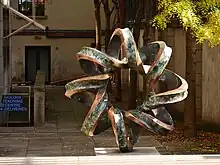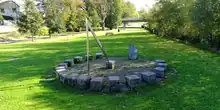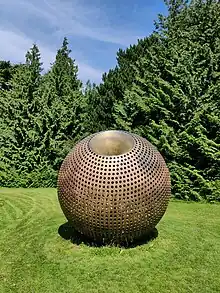Brian King | |
|---|---|
| Born | 13 October 1942 |
| Died | 16 April 2017 (aged 74) |
| Nationality | Irish |
| Alma mater | National College of Art and Design |
| Known for | sculpture, land art |
| Movement | Modern sculpture |
| Children | 3 |
| Elected | Aosdána |
Brian King (13 October 1942 – 16 April 2017) was an Irish sculptor. He mostly worked in large-scale metal sculptures in an abstract, minimalist style, as well as in environmental art and land art.[1]
Early life

Brian King was born in Dublin in 1942. He graduated from National College of Art and Design (NCAD, Dublin) in 1963.
Career




King participated in the Irish Exhibition of Living Art from 1964 to 1978, winning the Carroll Award there in 1965. He was the event's presiding officer from 1968 to 1978.[1] In 1969 and 1983 he represented Ireland at the Paris Biennale; he won the Biennale's major individual prize in 1969, the first Irish artists to do so.[1]
His early work was minimalist and was compared to J. S. Bach's music.[2]
He taught at NCAD from 1984 to 2004, becoming head of the sculpture department.[1]
Holdings
King produced many pieces of public art, found around Ireland.[3] King's work is also held in many public collections, including those of Dublin's Hugh Lane Municipal Gallery, Cork's Crawford Municipal Gallery, University College Dublin and the University of Ulster, as well as the semi-public collection of RTÉ and the private collections of Bank of Ireland and Allied Irish Banks.[1]
Personal life
King suffered ill health due to working with resin without proper protection. He died in 2017.[4]